Note: This website was automatically translated, so some terms or nuances may not be completely accurate.
For both studying and hobbies, Gen Z's video viewing isn't solely about prioritizing "time efficiency."
The spread of COVID-19 drastically altered the environment surrounding university students, making remote classes and remote job interviews commonplace. How they spend their leisure time has changed, significantly altering their media consumption patterns. Furthermore, among Generation Z, viewing videos at double speed or skipping content has become the norm, giving rise to keywords like "time performance" (TP), which measures viewing time and satisfaction.
Amidst these changes, Dentsu Inc. Media Innovation Lab, in collaboration with Professor Yasutoshi Mori of Kwansei Gakuin University's Faculty of Sociology, conducted a questionnaire survey on video viewing habits among sociology students at five universities in the Tokyo and Kansai metropolitan areas. ( Details here )
This report introduces survey results from two perspectives: "viewing for learning" (e.g., lecture videos, university entrance exam preparation) and "viewing for entertainment." Hasegawa So from Dentsu Inc. Media Innovation Lab and Kumakawa Airin, who is close in age to Generation Z, analyze the findings alongside Professor Mori's insights.
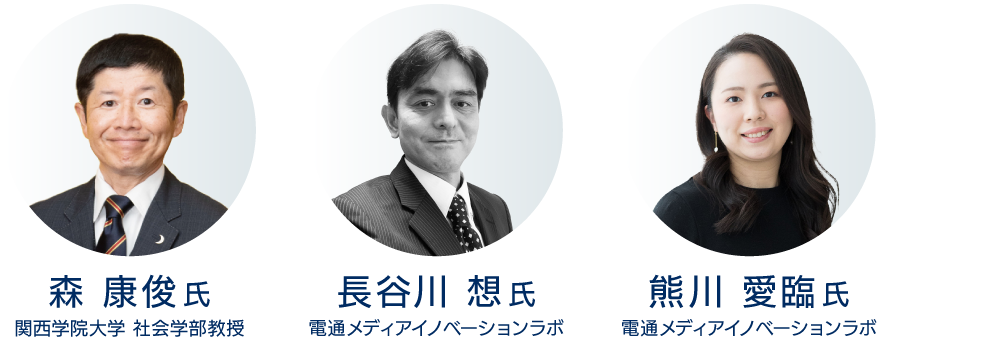
<Table of Contents>
▼80-90% of university students watch lecture videos at double speed or skip parts
▼YouTube videos serve as a bridge from high school's standardized learning to university's free learning
▼Does Generation Z want to reduce smartphone usage?
▼They want to efficiently access good content without wasting time
▼The content power of terrestrial broadcasts resonates with Generation Z too
▼What's needed is a strong message with high empathy
80-90% of college students watch lecture videos at double speed or skip parts
Hasegawa: Media consumption habits changed significantly during the stay-at-home period of the COVID-19 pandemic. Current university students, in particular, have had remote classes as the norm since starting university and experienced extended periods of staying home.
Since 2020, watching lectures via video has become commonplace due to the pandemic. First, let me share two key findings regarding viewing habits for learning purposes.
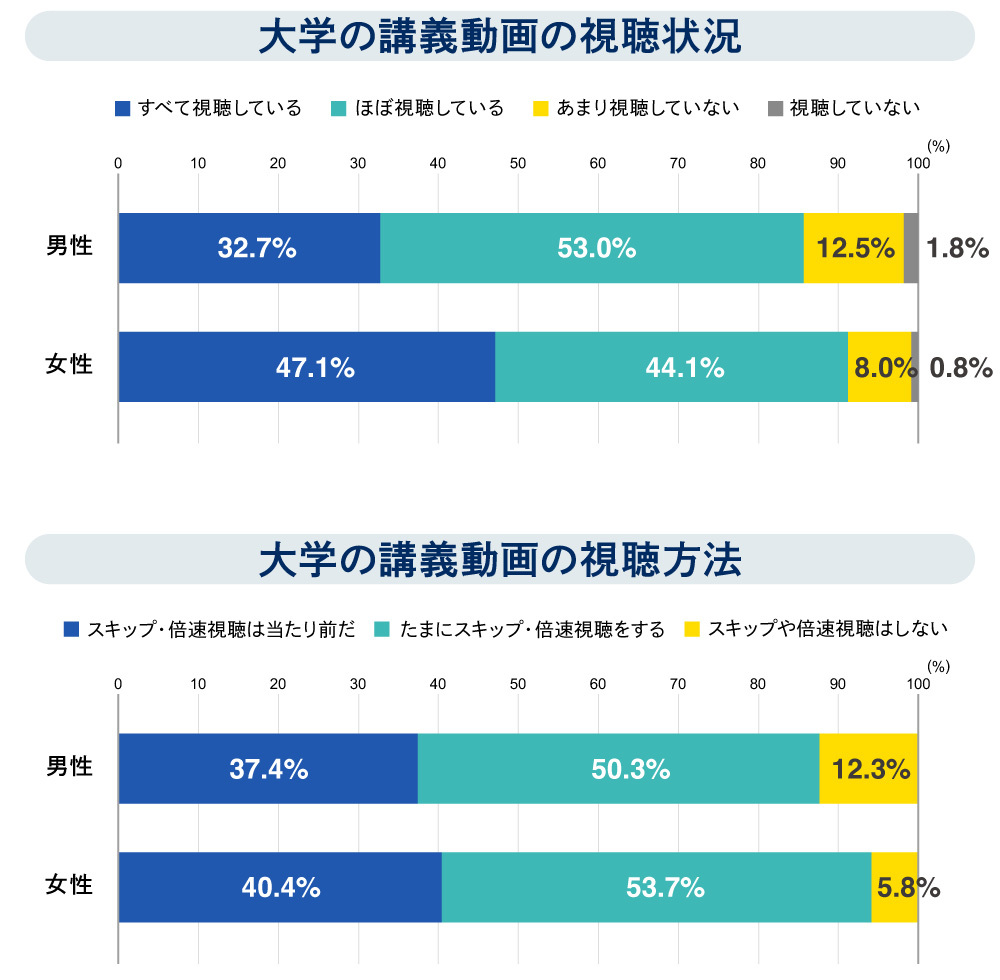
Hasegawa: Roughly 90% of students watch lecture videos, and about 90% of them report using speed-up or skipping features—something not possible in real-life classes. While we're still gathering insights on the effectiveness of online classes, Professor Mori, what are your thoughts on student motivation and the educational impact?
Mori: In-person lectures delivered directly to students inevitably tend to become redundant. When explaining academic concepts, I would repeatedly start by using formal, precise language and then simplify the explanation.
Online lectures, however, involve speaking directly into a microphone. This naturally fosters a mindset to speak slowly and clearly in precise Japanese, even as an amateur. Consequently, my delivery became simpler and more concise than in the classroom, making explanations easier to understand and reducing the lecture length. While my lectures at Kwansei Gakuin University are 100 minutes long, the recorded videos now cover the same content in about 60 minutes.
In other words, lecture videos, stripped of unnecessary noise, are easier to absorb even when watched at double speed or skipped. Unlike live classes, videos can be rewatched as many times as needed if something isn't understood. This reassurance likely contributed to the high number of students watching at double speed or skipping sections.
Moreover, students in any era naturally want to achieve good grades with minimal effort. In the past, "note shops" operated near universities, selling handwritten lecture notes. Students would purchase these notes or get copies from acquaintances to efficiently prepare for exams.
Today, we live in an era of full, constant access to educational materials, placing students in a state of perpetual information overload. It's only natural that they develop a desire to compress information and learn as efficiently as possible. Consequently, it seems likely that they've started watching videos at double speed or skipping through them.
Hasegawa: It's fascinating how learning styles have changed, and how professors' teaching styles and lecture approaches have evolved too.
YouTube videos serve as a bridge between high school's standardized learning and university's free-form learning.
Hasegawa: Next, these results come from a survey asking university students what they referenced during their university entrance exams. As you can see, they actively incorporated videos into their studies, with YouTube videos appearing particularly high in the ratio.
Looking at the specific content of these YouTube videos, many respondents cited subjects like English and history, and especially mentioned referencing lesson videos by comedians. Amidst the abundance of information accessible via smartphones, it's clear they actively sought out videos and tools suited to them and utilized them for learning. Also, since YouTube already had speed-up and skip functions back then, they might have watched these videos at accelerated speeds.
How do you, as a millennial, interpret these results?
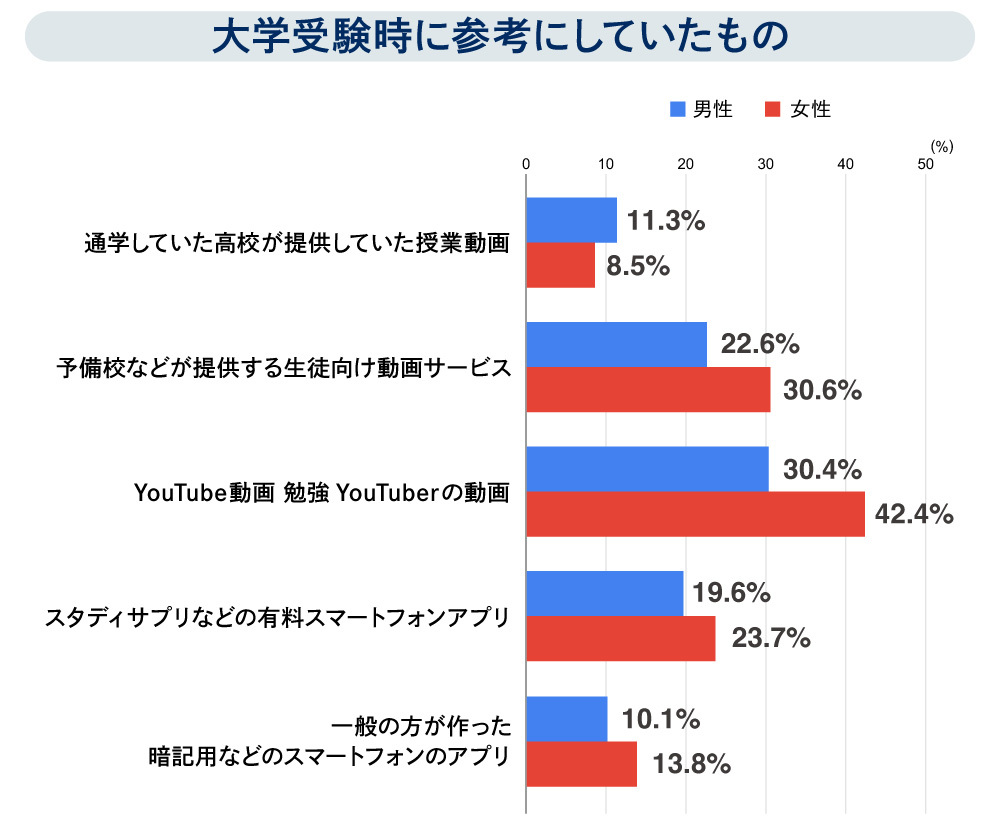
Kumagawa: I hear that YouTube videos and apps like Study Sapuri are highly effective for students who cannot attend cram schools or tutoring centers due to financial or distance constraints. On the other hand, students have also voiced concerns like, "When we use smartphones, it looks like we're just playing around to our parents' generation, which is troublesome." It seems adults also need to understand the reality that students might be using smartphones for learning.
Hasegawa: Considering the initial survey results we showed earlier, it also suggests that many university students have been using features like YouTube's speed playback for learning since high school—meaning they're accustomed to accelerated learning. Professor Mori, what are your thoughts on this point?
Mori: It's highly likely that the habit of using speed-up viewing developed while watching videos for entrance exam preparation. About 40 years ago, I attended a public high school known for preparing students for elite universities. I remember finding the standard curriculum rather dull. What compensated for this was the cram school culture. Back then, there were the three major cram schools. Attending lectures by their famous instructors and reading their publications provided stimulation. Cram schools seemed to bridge the gap between the less stimulating learning up to high school and the more free and self-directed learning in university.
Today, YouTube videos likely fulfill that same function. Language learning videos, in particular, often specialize in "listening" and "speaking," benefiting users of all ages, not just exam candidates. Learning apps also feature functions well-suited for memorization and repetitive practice, and it seems exam candidates understand and utilize their usefulness.
History, once studied solely through textbooks, can now be accessed through YouTube videos that provide clear, comprehensive explanations of Japanese and world history. This allows for a horizontal understanding of history, not just test score improvement, offering a stimulating experience reminiscent of the old cram school culture. It seems content like YouTube ( ) serves as a bridge connecting high school-style learning to university-style learning.
Does Generation Z want to reduce smartphone usage?
Hasegawa: So far, we've discussed learning-related topics. Next, I'd like to ask about smartphone usage in daily life overall. The following graph shows responses from university students when asked about their overall lifestyle, focusing on smartphone usage.
It reveals that while many university students feel "smartphone usage increased due to the pandemic," they simultaneously "want to reduce their usage frequency." Furthermore, regarding not just classes but also watching videos for hobbies, 40% of female university students responded that "watching something in a short time gives me satisfaction." The results also show that about one-third of students feel they lack time more than money.
Considering these survey results and your own experiences, what are your thoughts, Kumagawa-san?
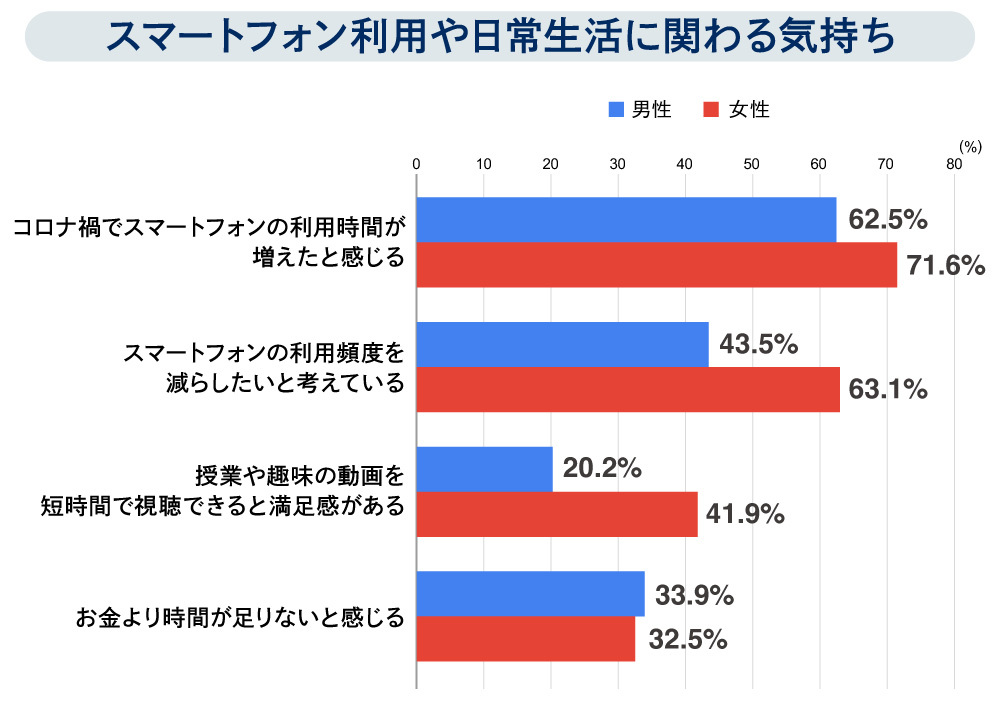
Kumagawa: There's no doubt that increased time spent at home has led to more smartphone usage. In group interviews conducted by Dentsu Inc. in August 2022 with university students and young professionals in their early 20s, comments like "my eyes get bored" while using a hair dryer emerged. This suggests smartphone use is accelerating in various scenarios during home time, such as gathering hobby-related information while drying hair.
On the other hand, features like screen time tracking make it easy to see how much time one actually spends looking at screens, and this seems to be strengthening the desire to reduce usage time.
Furthermore, the group interviews revealed that many young people, including males, are highly conscious about sleep. Some even expressed concerns about the impact on their appearance and were mindful of their sleep duration. It's plausible that prolonged smartphone use is not only causing vision deterioration but also shortening sleep time.
Hasegawa: Professor Mori, you interact with university students regularly. Considering their lifestyles, especially after the pandemic, have you noticed any particular changes?
Mori: This strays from the topic of smartphone use, but one thing struck me as odd during the pandemic: the increase in members joining athletic clubs. I'm involved with clubs myself, and traditionally, one challenge for athletic clubs was how to include beginners. Especially at private universities, teams like soccer, rugby, American football, and baseball were often already formed around experienced players, making it difficult for beginners to join. Yet, students who entered university during the pandemic are joining these very clubs.
Hasegawa: How do you analyze the reasons for this at this stage?
Mori: Given the tense global atmosphere in 2020, students who were previously unconnected to athletic clubs may have chosen to join out of a desire to stay connected to their university. Another possibility is that the inability to conduct high-level practices lowered the barrier for newcomers. Particularly during periods when part-time work wasn't possible, new members increased. Perhaps because athletic clubs offer a more tangible sense of university life compared to general interest clubs, many seemed to stay with their clubs without quitting.
Wanting to efficiently access good content without wasting time
Hasegawa: Now, let's move on to the results regarding video viewing for hobbies and other non-study purposes.
The graph below shows responses to "I enjoy movies and books after learning about their content or reviews," which relates to so-called "spoiler viewing." Over 20% of female respondents indicated this behavior.
Furthermore, similar to lecture videos, we confirmed that a certain percentage of students regularly watch movies and other hobbies/entertainment at double speed.
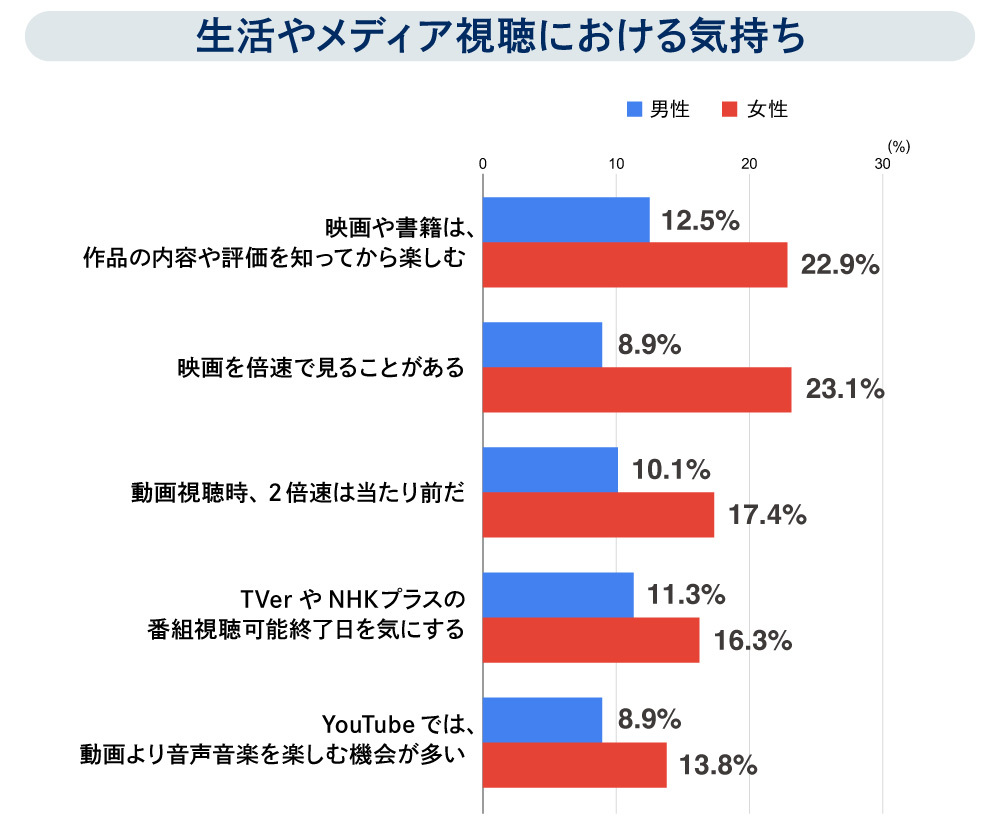
Kumagawa: The so-called "spoiler viewing" likely stems from a desire to avoid wasting time, not wanting to endure uninteresting videos, and not wanting to make a mistake. When watching a video of a type they don't usually watch, where the level of enjoyment is unknown, they often use fast-forward or skip functions to progress through the content. If they find an interesting scene or one featuring their favorite character, they may switch back to normal speed to watch it. There may also be a desire to accurately understand plot threads that influence the story's conclusion, often referred to as "payoff of foreshadowing."
Hasegawa: Both "spoiler viewing" and "double-speed viewing" have a higher proportion of female users.
Kumagawa: It might be that women simply have a greater volume of videos they're interested in.
Hasegawa: Professor Mori, have you noticed any particular attitudes among today's university students regarding their consumption of entertainment content?
Mori: I sense two main feelings: not wanting to waste money and not wanting to waste time. Looking at the survey results, the desire to avoid wasting time appears stronger, and this tendency is particularly high among women.
So far, we've compared how past functions are being replaced by modern content and platforms. When I was a university student, motivated by not wanting to waste money, I would consult magazine reviews before buying records or going to the movies. For example, with Western music, I'd read new release reviews in music magazines and think, "If this writer recommends it, I'll trust them and buy it." Money is finite, so the motivation to access better music within limited resources existed in our time too.
The same applies to movies. For arthouse films, I wanted to understand the context before watching. If there were complex backstories, I'd absorb film critics' explanations beforehand—essentially doing what we'd now call "paying attention to foreshadowing." Now, explanatory YouTubers cover music history and film contexts, suggesting a shift from print to video media.
Furthermore, today's university students might have a stronger desire to only engage with the best content. When talking with students, I sometimes get questions like, "Can you recommend a Christmas movie that makes you cry?" When I suggest a title, they immediately look it up and say, "I'll watch it." I believe this is because having a connoisseur recommend something saves them the effort of searching for just one film from the vast sea of options themselves.
Now that both music and movies are accessible through subscription services, the younger generation has a weaker sense of paying for individual pieces of content. Therefore, rather than being afraid of wasting money, I think they have a stronger desire to efficiently access good content.
The appeal of terrestrial broadcast content to Gen Z
Hasegawa: The survey mentioned above confirmed that, while viewing of NHK and commercial broadcasters' catch-up services is expanding, there are distinct groups: one that enjoys viewing while mindful of the roughly one-week viewing window, and another that uses YouTube more for music than videos.
While habits like watching TV programs live and enjoying videos on YouTube have existed, it feels like a new trend is emerging in how people consume media. What's your take, Kumakawa?
Kumakawa: The pandemic has increased opportunities for university students to control their own time through remote and on-demand classes, and for working adults through remote work. Additionally, services have improved with increased video content and support for connected TVs. As a result, trends like watching TV programs on-demand whenever convenient or listening to music on YouTube via PC or smartphone while studying are likely accelerating.
Hasegawa: The pandemic has altered the relationship between media and contact time, accelerating more complex media engagement. This includes various forms of "multitasking" and adapting media use to the length of spare moments. For example, using TikTok during short breaks and YouTube when more time is available is becoming common. This marks a significant shift from the heyday of mass media and the subsequent internet era centered around PC use. Professor Mori, what are your thoughts?
Mori: Observing university students, I feel terrestrial broadcast television still holds significant power regarding entertainment content. This is also confirmed by the findings of this survey. Content related to comedians and idols often originates from television, and I reaffirmed that its influence remains strong.
However, this survey also showed that about 20% of single men living alone don't own a TV. I also see signs of male students moving away from TV programs and TV sets themselves.
H asegawa: We may need to distinguish between turning away from TV programs and turning away from TV sets themselves. Content providers also need to devise ways to increase touchpoints.
What's needed is a strong message with high resonance
Hasegawa: Finally, what do you think is necessary for content and advertising to be more readily accepted by university students? Please share your thoughts, Mr. Kumakawa and Professor Mori.
Kumagawa: Lately, especially in marketing messages, I get the impression communication tends to be indirect and avoids making strong assertions. In this environment, I believe direct, strong messages with high resonance could be effective. Amidst a constant barrage of information hitting our eyes and ears, it's crucial to devise ways for messages to be instantly perceived as meaningful to the individual or society, depending on the context and situation of exposure.
Another point is that young people view their time as precious. They have a strong desire to control their own time, so the timing of ad placement, especially in online videos, is a crucial factor.
While TV commercials flow naturally with the program, online ads can suddenly interrupt. In group interviews conducted this summer, participants expressed dislike, saying, "When ads pop up mid-video, it feels like my time is being stopped."
Conversely, some mentioned that "ads on certain social media platforms often feel tailored to me, which I appreciate." Precisely because these ads target young people who value their time, how and where ads are placed is a major challenge.
Mori: Mr. Kumagawa mentioned earlier that "there are many indirect messages." Actually, the same trend is visible in university settings. In university communication, expressions that avoid assertive, core messages and instead leave judgment or interpretation to the listener—meaning the course participants—are becoming widespread. This applies to lectures, and even messages universities request of students use phrasing that avoids strong assertions.
This stems from heightened university awareness regarding harassment. Correct phrasing and behavioral norms—like using "-san" when addressing students regardless of gender—have become established guidelines, and we've adopted them.
Similar to the marketing field, there may eventually be a demand from the audience for clearer statements, for criticism on whether something is good or bad, and for messages delivered in a stronger or more charismatic manner.
*Percentage composition is rounded to the second decimal place, so totals may not always add up to 100%.
【Survey Overview】
Period: June 2022
Participants: 533 undergraduate students from Kwansei Gakuin University, Tokyo Keizai University, Rikkyo University, and 2 other universities (listed in Japanese syllabary order / Male: 168, Female: 363, Other: 2)
Survey Format: Utilized Google Forms to request cooperation from students enrolled in media-related courses
Research Cooperation:
Professor Yasutoshi Mori, Faculty of Sociology, Kwansei Gakuin University
Professor Kazuto Tamura, Faculty of Communication, Tokyo Keizai University
Professor Ryo Korenaga, Faculty of Sociology, Rikkyo University
Recommended articles related to Generation Z
・The Future Seen Half a Step Ahead by Young People
・A White Paper on Generation Z Women's Consumption
・Comparing Generation Z with Millennials and Generation Y: Their Media Awareness and Mentality
Was this article helpful?
Newsletter registration is here
We select and publish important news every day
For inquiries about this article
Author

Yasutoshi Mori
Kwansei Gakuin University
School of Social Sciences
Professor
Born in Osaka in 1967. Withdrew from the doctoral program at the Graduate School of Humanities and Sociology, University of Tokyo in 1999 after completing coursework. Specializes in mass communication theory, information society theory, and disaster information theory. Engaged in social surveys on media usage behavior and disaster/disaster prevention since the late 1990s. Contributing author to: Yoshiaki Hashimoto (ed.), "Information Behavior of the Japanese 2020" (University of Tokyo Press); Toshi Inoue and Kimio Ito (eds.), "Media, Information, and the Consumer Society (Sociology Basics 6)" (Sekai Shisōsha); "Encyclopedia of Disaster Information Studies" (Asakura Shoten), among others.

Hasegawa So
Dentsu Inc.
Dentsu Inc. Media Innovation Lab
Director of Media Innovation Research
After working on the development and operation of information media services at a domestic telecommunications carrier, joined Dentsu Inc. Primarily handled media planning and digital marketing before assuming current position. Interested in information behavior, media business, advertising media development, and local media. Master of Interdisciplinary Information Studies. Marketing Meister, Japan Marketing Association.

Ai Kumagawa
Dentsu Inc.
Dentsu Inc. Media Innovation Lab
Researcher
After joining the company, I have been conducting research on Japan's advertising media market and marketing-related fields. I am responsible for projects including "Japan's Advertising Expenditures," "Detailed Analysis of Internet Advertising Expenditures," and "Global Advertising Expenditures." Since 2021, I have also participated in research activities at the Audience Research Institute.




